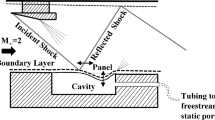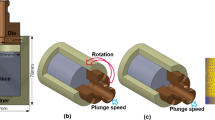Abstract
Purpose
This paper presents an experimental and numerical study to evaluate the impact energy dissipation, proposing a dry friction damper using spherical elements as a dissipation mechanism.
Methods
The study is performed by experimentation using a universal testing machine with cyclic testing and numerical modeling using Abaqus finite element software. Energy dissipation analysis is presented by comparing the loading and unloading cycles in the device, in addition, the dissipator was subject to dynamic loading, with parametric variation of the impact velocity and mass.
Results
The results show the feasibility of using confined spheres as energy dissipation elements by means of dry friction, dissipating 41% of the energy input to the system. Numerical and experimental analysis show an acceptable percentage differential of 2%. The dynamic modeling of the device under the analyzed parameters does not show considerable variation in the energy dissipation capacity for different velocities.
Conclusions
The use of confined spherical elements as a dry friction energy dissipation mechanism is feasible. The device is able to dissipate 41% of the input energy resulting from the impact through dry friction at the sphere-tube contact. The operating range of the energy dissipator is variable depending on the clamping torque in the system. Due to the geometry and the easy market accessibility of the components that make up the device, it is a good alternative for dry friction energy dissipation.


Source: prepared by the authors

Source: prepared by the authors

Source: prepared by the authors

Source: prepared by the authors

Source: prepared by the authors

Source: prepared by the authors

Source: prepared by the authors

Source: prepared by the authors

Source: prepared by the authors

Source: prepared by the authors

Source: prepared by the authors

Source: prepared by the authors

Source: prepared by the authors

Source: prepared by the authors

Source: prepared by the authors

Source: prepared by the authors

Source: prepared by the authors

Source: prepared by the authors

Source: prepared by the authors

Source: prepared by the authors

Source: prepared by the authors

Source: prepared by the authors

Source: prepared by the authors
Similar content being viewed by others
References
De Silva CW (ed) (2005) Vibration and shock handbook. CRC Press, Boca Raton
Mayorga Vela CA (2011) Caracterización mecánica y modelamiento estructural de un disipador pasivo de energía de tipo arriostramiento de pandeo restringido. Parte 2. Departamento de Ingeniería Civil y Agrícola.
Pasquin C, Leboeuf N, Pall RT, Pall A (2004) Friction dampers for seismic rehabilitation of Eaton’s building, Montreal. In 13th world conference on earthquake engineering. pp. 1–2.
Jaisee S, Yue F, Ooi YH (2021) A state-of-the-art review on passive friction dampers and their applications. Eng Struct 235:112022
Pall AS, Marsh C, Fazio P (1980) Friction joints for seismic control of large panel structures. J Prestress Concr Inst 25(6):38–61
Wu B, Zhang J, Williams MS, Ou J (2005) Hysteretic behavior of improved Pall-typed frictional dampers. Eng Struct 27(8):1258–1267
Fitzgerald TF, Anagnos T, Goodson M, Zsutty T (1989) Slotted bolted connections in aseismic design for concentrically braced connections. Earthq Spectra 5(2):383–391
Wang G, Wang Y, Yuan J, Yang Y, Wang D (2017) Modeling and experimental investigation of a novel arc-surfaced frictional damper. J Sound Vib 389:89–100
Martínez CA, Curadelli O (2017) Testing and performance of a new friction damper for seismic vibration control. J Sound Vib 399:60–74
Lu Y, Hao G, Han Q, Huang J (2020) Steel tubular friction damper and vibration reduction effects of double-layer reticulated shells. J Constr Steel Res 169:106019
Domínguez-Gurría MA, Szwedowicz D, Martínez E, Cortés C, Estrada Q (2023) Anti-fall safety system with variable stiffness layers. J Vib Eng Technol. 12(2):2035–2041
Pesaresi L, Stender M, Ruffini V, Schwingshackl CW (2017) DIC measurement of the kinematics of a friction damper for turbine applications. Dynamics of coupled structures, vol 4. Springer, Cham, pp 93–101
Perkowski W (2016) Dry friction damper for supercritical drive shaft. J KONES. 23:389
Sun Y, Yuan J, Pesaresi L, Denimal E, Salles L (2020) Parametric study and uncertainty quantification of the nonlinear modal properties of frictional dampers. J Vib Acoust 142(5):051102
Sazhenkov N, Semenova I, Nikhamkin M, Semenov S (2017) A substructure-based numerical technique and experimental analysis of turbine blades damping with underplatform friction dampers. Procedia engineering 199:820–825
Lopez I, Busturia JM, Nijmeijer H (2004) Energy dissipation of a friction damper. J Sound Vib 278(3):539–561
Saeki M (2009) Energy dissipation model of particle dampers. In: 50th AIAA/ASME/ASCE/AHS/ASC Structures, Structural Dynamics, and Materials Conference 17th AIAA/ASME/AHS Adaptive Structures Conference 11th AIAA No. p 2692.
Zheng L (2013) Experimental investigation of a nonlinear damper system. In: 2013 25th Chinese Control and Decision Conference (CCDC). IEEE. pp 1392–1397.
Lu Z, Masri SF, Lu X (2011) Parametric studies of the performance of particle dampers under harmonic excitation. Struct Control Health Monit 18(1):79–98
Booty C, Bowyer EP, Krylov VV (2014) Experimental investigation of damping flexural vibrations using granular materials. Proc. ISMA 2014 Int. Conf. Noise Vib. Eng. USD 2014 Int. Conf. Uncertain. Struct. Dyn. p 547–558
Trigui M, Foltete E, Abbes MS, Fakhfakh T, Bouhaddi N, Haddar M (2009) An experimental study of a multi-particle impact damper. Proc Inst Mech Eng C J Mech Eng Sci 223(9):2029–2038
Zhang K, Xi Y, Chen T, Ma Z (2018) Experimental studies of tuned particle damper: Design and characterization. Mech Syst Signal Process 99:219–228
Schmid SR, Hamrock BJ, Jacobson BO (2014) Fundamentals of machine elements SI version, 3rd edn. CRC Press, Boca Raton
Norton Robert L (2011) Diseño de máquinas: Un enfoque integrado. Prentice Hall, Hoboken
Meriam JL, Karige LG (2002) Engineering mechanics: statics (volume I) and engineering mechanics. Dynamics. 2. Chapter 6, pp 357–360
Chowdhury MA, Nuruzzaman DM, Roy BK, Islam A, Hossain Z, Hasan MR (2013) Experimental investigation of friction coefficient and wear rate of stainless steel 202 sliding against smooth and rough stainless steel 304 counter-faces. Friction Wear Res 1(3):34–41
Bedolla J, Szwedowicz D, Jiménez J, Majewski T, Cortés C, Gutierrez-Wing ES (2014) Improvement of dynamic response in an impact absorber by frictional elements. J Mech Sci Technol 28:1349–1363
Author information
Authors and Affiliations
Corresponding author
Additional information
Publisher's Note
Springer Nature remains neutral with regard to jurisdictional claims in published maps and institutional affiliations.
Rights and permissions
Springer Nature or its licensor (e.g. a society or other partner) holds exclusive rights to this article under a publishing agreement with the author(s) or other rightsholder(s); author self-archiving of the accepted manuscript version of this article is solely governed by the terms of such publishing agreement and applicable law.
About this article
Cite this article
Domínguez-Gurría, M.A., Szwedowicz, D., Rodríguez, A.G. et al. Dry Friction Energy Dissipater with Spherical Elements. J. Vib. Eng. Technol. (2024). https://doi.org/10.1007/s42417-024-01371-7
Received:
Revised:
Accepted:
Published:
DOI: https://doi.org/10.1007/s42417-024-01371-7




